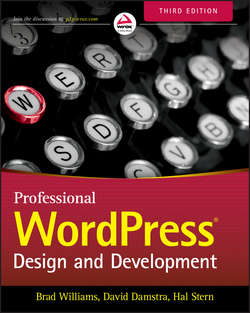Читать книгу Professional WordPress. Design and Development - Brad Williams - Страница 12
На сайте Литреса книга снята с продажи.
1
First Post
CONTENT AND CONVERSATION
ОглавлениеMultiple linear feet of shelves in bookstores are filled with volumes that will improve your writing voice, literary style, blogging techniques, and other aspects of your content creation abilities. One of the goals of this book is to define the visual, stylistic, and context management mechanisms you can build with WordPress to shape vibrant user communities around your content. That context stimulates conversation with your readers. Publishing is not just about the words in each post, or even if you are an interesting writer. How will people find you? How will you stand out in the crowd? How do you put your own imprint on your site, and personalize it for whatever purpose: personal, enterprise, community, or commercial?
WordPress as a Content Management System
Blogging systems have their roots in simple content management operations: Create a post, persist it in stable storage such as a filesystem or database, and display the formatted output based on some set of temporal or keyword criteria. As the richness and types of content presented in blog pages expanded, and the requirements for sorting, searching, selecting, and presenting content grew to include metadata and content taxonomies, the line between vanilla, single-user-targeted blogging software and enterprise-grade content management systems blurred.
Content management systems (CMS) handle the creation, storage, retrieval, description or annotation, and publication or display of a variety of content types. CMS also covers workflow tasks, typically from an editorial or publishing perspective, and includes actions such as approval and marking content for additional editing or review. The WordPress Dashboard provides those elements of workflow management and editorial control. WordPress is not the only open source content management system in widespread use today; the Drupal and Joomla projects are equally popular choices. Drupal and Joomla start from the perspective of managing content repositories; they handle a variety of content types, multiple authors in multiple roles, and delivering the content to a consumer that requests it. WordPress is at its heart a publishing system, and the end focus is on displaying content to a reader. Although areas of functional overlap exist, you can integrate WordPress with other content management systems, a process covered in detail in Chapter 15.
WordPress has established itself as a bona fide content management system through its design for extensibility and the separation of content persistence from content display. Taking some liberties with the Model-View-Controller design pattern, WordPress separates the MySQL persistence layer as a data model, the theme-driven user interface and display functions, and the plugin architecture that interposes functionality into the data to presentation flow. Most important, WordPress stores content in raw form, as input by the user or an application posting through the WordPress APIs. Content is not formatted, run through templates, or laid out until the page is rendered, yielding immense power to the functions that generate the actual HTML. At the same time, the data model used by WordPress uses a rich set of tables to manage categories (taxonomies), content tags (folksonomies), author information, comments, and other pieces of cross-reference value. The WordPress database schema that makes this possible is explored in Chapter 6.
Although that design gives WordPress incredible power and flexibility as a content management system, it also requires knowledge of how those data persistence and control flows are related. (It was a search for such a dissection of WordPress in functional terms that got us together to write this book.)
Creating Conversation
Conversation is king; content is just something to talk about.
– Cory Doctorow
A robust CMS is measured by the utility of its content. Even the richest content types and most well-managed processes are of low return if nobody actually consumes the outputs. It is not sufficient to install blogging software, write a few posts, and hope the world shows up on your virtual doorstep; you need to create what Tim O’Reilly calls an “architecture of participation.” Social networking, advertising, feeds, and taking steps to ensure your site shows up in search engine results will drive readers to your site; the design, branding, and graphic elements coupled with the quality of your content will encourage them to take the steps toward active participation.
Look at the problem from the perspective of a reader: In a world of tens of millions of websites (many of which have a “first post” and not much else), how will you be found, heard, and echoed? Your Twitter followers should want to read your site, and your WordPress site can update your Twitter feed. Conversely, your Twitter updates may appear in your WordPress sidebar, marrying the ultra-short content timeline to the more thoughtful one. If you are active on Facebook, you can import entries into a public figure page and Facebook readership will drive traffic back to your website. If you cover specific, detailed, or arcane areas in your writing, Google searches for those terms should direct readers to you, where they will join the conversation. Chapter 12 looks at how your WordPress content can be more broadly distributed.
